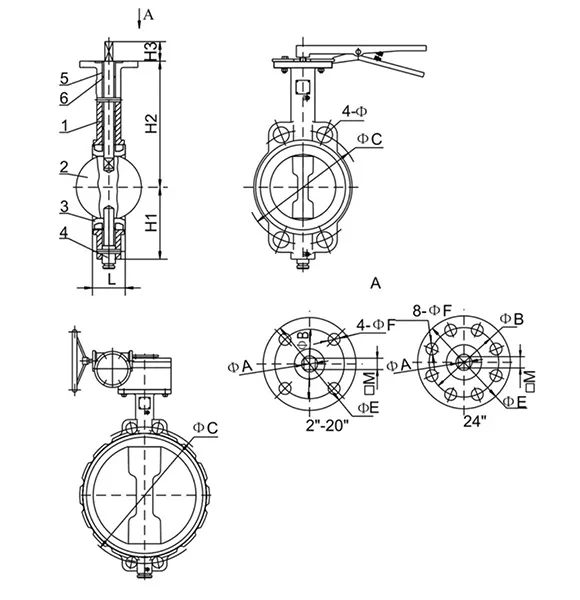Nov . 28, 2024 04:09 Back to list
Y Strainer PN16 Specifications and Applications for Efficient Fluid Filtration
Understanding Y-Strainers and Their Importance in Fluid Systems
In the vast realm of industrial fluid management, components that ensure smooth operation and longevity of systems are indispensable. One such crucial component is the Y-strainer, particularly the PN16 rated Y-strainer. Understanding its design, application, and maintenance can greatly enhance the efficiency and reliability of various fluid systems.
What is a Y-Strainer?
A Y-strainer is a type of filter used in pipelines to remove unwanted particles from liquids or gases. Its unique shape, resembling the letter 'Y', allows for effective filtration while facilitating flow. The primary function of a Y-strainer is to protect downstream equipment such as pumps, valves, and nozzles from damage caused by debris or sediment. This is achieved by using a mesh screen, which traps particles while allowing the fluid to pass through.
The Importance of PN16 Rating
The designation PN16 refers to the pressure nominal of the strainer, indicating that it can withstand pressures up to 16 bar (approximately 232 psi). This attribute makes the PN16 Y-strainer suitable for a wide range of applications in various industries, including water treatment, oil and gas, chemical manufacturing, and HVAC systems. The ability to operate at higher pressures means that it can be utilized in more demanding environments without compromising safety or performance.
Design and Construction
Y-strainers are typically constructed from materials such as stainless steel, cast iron, or bronze, depending on the application and the type of fluid being filtered. Stainless steel, for instance, is highly resistant to corrosion, making it ideal for harsh chemicals. The strainer comprises a body, a cover, and a mesh filter (available in varying mesh sizes), which can be easily removed for maintenance and cleaning.
The design of the Y-strainer not only allows for effective filtering but also minimizes pressure drops, making them efficient in systems where maintaining flow rates is critical. They can be installed in horizontal or vertical pipelines, providing flexibility in system design.
y strainer pn16

Applications of Y-Strainers
Y-strainers find application in diverse fields, and their utility is evident in everyday processes. In water treatment facilities, they help maintain clean water output by filtering out particulates. In the oil and gas industry, Y-strainers protect pumps and compressors from abrasive elements that can cause failure or degradation over time.
In HVAC systems, they ensure that cooling and heating fluids remain free of contaminants, thus improving system efficiency and extending equipment life. Furthermore, Y-strainers are essential in chemical processing plants where maintaining fluid purity is paramount.
Maintenance and Best Practices
To ensure optimal performance of a Y-strainer, regular maintenance is crucial. It is essential to inspect and clean the mesh filter periodically, depending on the fluid's characteristics and the amount of debris present. In systems with high levels of contaminants, more frequent inspections may be necessary.
Choosing the right mesh size for the specific application is also important. A finer mesh can catch smaller particles, but it may also lead to increased pressure drop and require more frequent cleaning. Conversely, a coarser mesh may allow more debris through but may not effectively protect sensitive equipment.
When installing a Y-strainer, proper orientation is key. Generally, these are installed with the mesh screen horizontal to avoid sediment accumulation. Adequate space should also be left for maintenance access, ensuring quick and efficient cleaning when needed.
Conclusion
The Y-strainer, particularly the PN16 variant, is a vital component in various fluid systems across multiple industries. Its robust design, ability to handle high pressure, and effectiveness in filtering out unwanted particles make it an integral part of ensuring operational efficiency. By understanding its functionalities, applications, and maintenance needs, industries can enhance their fluid management processes, ultimately leading to improved equipment longevity and reliability.
Share
-
Reliable Wafer Type Butterfly Valves for Every IndustryNewsJul.25,2025
-
Reliable Flow Control Begins with the Right Ball Check ValveNewsJul.25,2025
-
Precision Flow Control Starts with Quality ValvesNewsJul.25,2025
-
Industrial Flow Control ReliabilityNewsJul.25,2025
-
Engineered for Efficiency Gate Valves That Power Industrial PerformanceNewsJul.25,2025
-
Empowering Infrastructure Through Quality ManufacturingNewsJul.25,2025